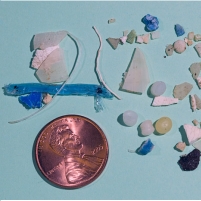Plastic Pollution in the Atlantic Ocean
Sunday, August 22, 2010
 Pieces of Plastic Collected in the North Atlantic Ocean (Photo: Tom Kleindinst, Woods Hole Oceanographic Institution)
Pieces of Plastic Collected in the North Atlantic Ocean (Photo: Tom Kleindinst, Woods Hole Oceanographic Institution)
Plastic garbage floating in the Atlantic Ocean is “a significant environmental concern,” according to oceanographers from the Sea Education Association (SEA), Woods Hole Oceanographic Institution and the University of Hawaii. In reviewing 22 years worth of data collected from water samples, the experts found 60% of them contained tiny pieces of plastic, most of which measured no more than a few millimeters. Despite their small size, the plastic has had important or even detrimental impacts on ocean life, such as sea animals becoming entangled or eating it.
In some instances the debris has acted as “life rafts” allowing species to migrate beyond their normal areas of the ocean. For example, SEA crew found a bucket, covered in algae, that was being used by about two dozen triggerfish, which normally live in coral reefs. In this case, the triggerfish were more than 1,000 miles from the nearest coral reef.
The amount of plastic thrown away in the United States alone has quadrupled in the last twenty years.
The largest amount of plastic—83%—is in an area known as the North Atlantic subtropical gyre, reaching from the latitude of Baltimore to that of the Bahamas. Most of the plastic collected on the sea surface is polypropylene, which is used in a wide variety of products that includes clear bags and rope; and polyethylene, which is primarily used for plastic shopping bags. However, the scientists found almost no PET, the substance used in plastic bottles, even though PET is commonly found littering beaches. This has led to speculation that the PET is sinking to the bottom of the ocean.
-David Wallechinsky, Noel Brinkerhoff
Plastic Particles Permeate the Atlantic (by Dave Lawrence, Oceanus)
Plastic in the North Atlantic (by R. Jude Wilbur, Sea Education Association) (pdf)
The Mystery of the Missing Plastic in the Atlantic Garbage Patch (by Andrew Moseman, Discover Magazine)
- Top Stories
- Unusual News
- Where is the Money Going?
- Controversies
- U.S. and the World
- Appointments and Resignations
- Latest News
- Trump to Stop Deportations If…
- Trump Denounces World Series
- What If China Invaded the United States?
- Donald Trump Has a Mental Health Problem and It Has a Name
- Trump Goes on Renaming Frenzy






Comments